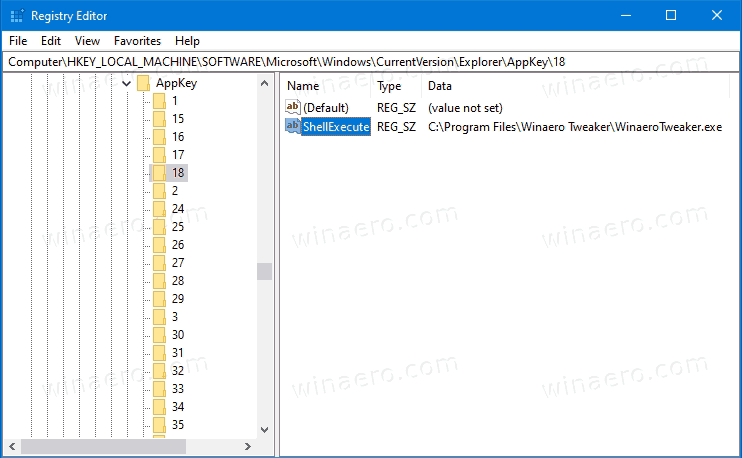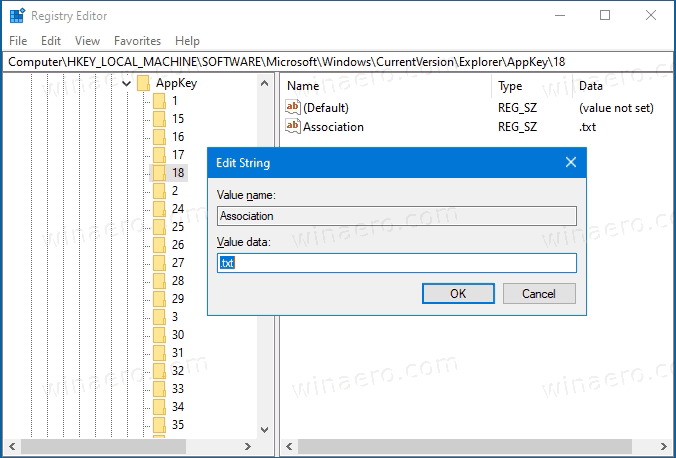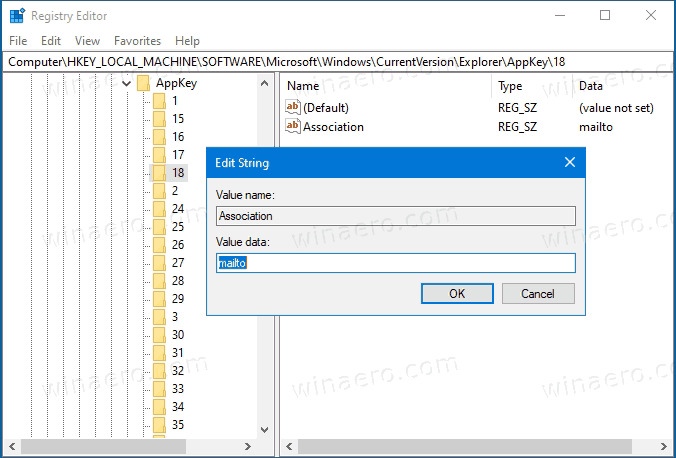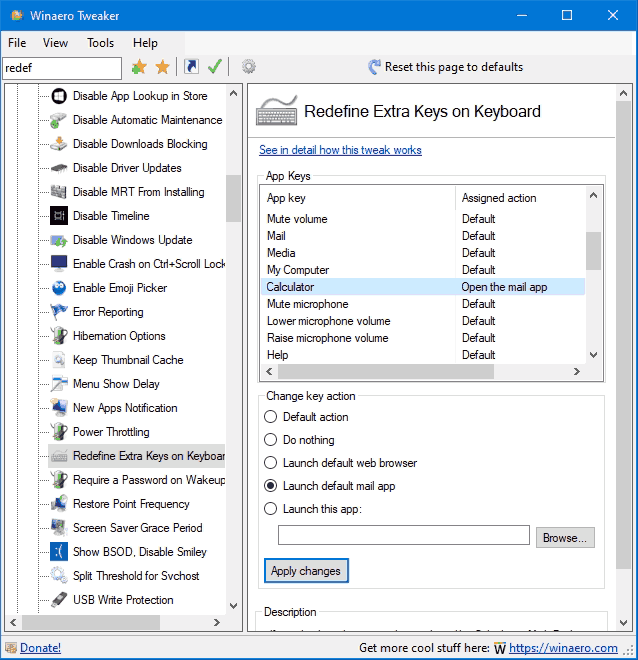How to Change What App Keys Do for the Keyboard in Windows 10, 8 and 7
Some keyboards contain a number of additional keys that you can use to launch a Windows application or perform a specific action. The most common keys are Calculator, Web Browser, Mail, Search. Microsoft keyboards are known for having these keys, but not only MS keyboards have them. Other manufacturers also have many models of multimedia keyboards with application keys.
Advertisеment
While custom keys often require a keyboard driver, Windows is able to recognize certain keys out of the box. It is a lesser known feature of the OS that you can customize what those keys do.
This post will show how to how to change what extra App Keys do for the Keyboard in Windows 10, 8 and 7.
Customize App Key Actions
The keys have a reference in Windows registry. There is a Registry branch for that:
HKEY_LOCAL_MACHINE\SOFTWARE\Microsoft\Windows\CurrentVersion\Explorer\AppKey\<KEY_NUMBER>There, <KEY_NUMBER> corresponds to a key on the keyboard which action can be customized manually.
E.g. the key HKEY_LOCAL_MACHINE\SOFTWARE\Microsoft\Windows\CurrentVersion\Explorer\AppKey\6 corresponds to the "Favorites" keyboard key, and the subkey name number 18 is Calculator.
Under such subkey, you can create two string (REG_SZ) values.
-
Association= ".txt" - open the default app that is set to open text files. By default it is Notepad. -
ShellExecute="C:\windows\notepad.exe". Run the specified app. In my case it is notepad.exe from the system folder.
You can use the above two values to change what this or that extra keyboard button do. Setting ShellExecute to an empty string will disable the keyboard key action, so the button will do nothing. You can only use the ShellExecute or Association string value (or none of them) for a key. It is not possible to use both the ShellExecute and Association string values together for a single key.
We will review below the procedure in detail. But first, see the app key reference to get corresponding Registry key names for the keyboard buttons.
Registry Key Names for Keyboard App Buttons
| Key | Description |
|---|---|
| 1 | Back (Web browser) |
| 2 | Forward (Web browser) |
| 3 | Refresh (Web browser) |
| 4 | Stop (Web browser) |
| 5 | Search |
| 6 | Favorites (Web browser) |
| 7 | Web Home (Web browser) |
| 8 | Mute Volume |
| 9 | Volume Down |
| 10 | Volume Up |
| 11 | Next Track (media) |
| 12 | Previous Track (media) |
| 13 | Stop (media) |
| 14 | Pause/Play (media) |
| 15 | |
| 16 | Media Select |
| 17 | This PC or My Computer |
| 18 | Calculator |
| 19 | Bass Down |
| 20 | Bass Boost |
| 21 | Bass Up |
| 22 | Treble Down |
| 23 | Treble Up |
| 24 | Mute Microphone |
| 25 | Volume Down Microphone |
| 26 | Volume Up Microphone |
| 27 | Help |
| 28 | Find |
| 29 | New |
| 30 | Open |
| 31 | Close |
| 32 | Save |
| 33 | |
| 34 | Undo |
| 35 | Redo |
| 36 | Copy |
| 37 | Cut |
| 38 | Paste |
| 39 | Reply (mail) |
| 40 | Forward (mail) |
| 41 | Send (mail) |
| 42 | Spell Check |
| 43 | Toggle Dictation on/off |
| 44 | Toggle Microphone on/off |
| 45 | Correction List |
| 46 | Play (media) |
| 47 | Pause (media) |
| 48 | Record (media) |
| 49 | Fast Forward (media) |
| 50 | Rewind (media) |
| 51 | Channel Up (media) |
| 52 | Channel Down (media) |
| 53 | Delete |
| 54 | Flip 3D |
Now, let's see how to redefine the key action. For example, I will customize the Calculator button (number 18).
To Change What App Keys Do for the Keyboard in Windows 10, 8 and 7
- Open the Registry Editor app.
- Go to the following Registry key.
HKEY_LOCAL_MACHINE\SOFTWARE\Microsoft\Windows\CurrentVersion\Explorer\AppKey\18. Replace18with the actual number for the key you want to customize. - On the right, modify or create a new string (REG_SZ) value ShellExecute.

- Set it to the full path to the app that you want to launch with your keyboard button.
- If you want to disable the key so it will do nothing, set the ShellExecute value data to the empty string.
You are done. Nothing else is required, the change will take effect instantly.
Alternatively, you can use another value, Association, instead of ShellExecute. Association can be set to any file extension, e.g. .txt, .mp3, .doc, etc, so the button will launch the default app set for that file extension. For example, for Association = .txt it can launch Notepad, Microsoft Word for .doc, and Windows Media Player for .mp3.
To Change What App Keys Do for the Keyboard with File Extension
- Open the Registry Editor app.
- Go to the following Registry key.
HKEY_LOCAL_MACHINE\SOFTWARE\Microsoft\Windows\CurrentVersion\Explorer\AppKey\18. Replace18with the actual number for the key you want to customize. - On the right, modify or create a new string (REG_SZ) value
Association. - Set it to
.txtto make the button open the default text editor app, e.g. Notepad. Replace.txtwith the file extension of your choice.
- Setting the
Associationvalue tohttpwill launch the default web browser. - Setting the
Associationvalue tomailtowill launch the default mail app.
- The change will take effect instantly.
You are done.
To save your time, you can use Winaero Tweaker. Starting in version 0.18, it allows redefining extra keyboard keys with the following GUI:

Using it, you can avoid the Registry editing completely.
That's it.
Support us
Winaero greatly relies on your support. You can help the site keep bringing you interesting and useful content and software by using these options:

How to make for example calculator key to become play/pause button? What if i need to make an action and not to open a file or executable? I can’t write a path to play/pause action, is there any commands like “http” or “mailto” for this needs?
You can use Microsoft PowerToys.
Install it and go to Keyboard Manager > Remap Keys > Remap a key
Now for the Key column, click on Type button and press Calculator button on your keyboard. Next in the Mapped To column click on Type button and press Play/Pause button on your keyboard.
Finally click on OK and confirm the changes.
That helped! Thanks.
That didn’t work for me on my Dell SK-813
Great stuff.
But, all our HP Elitebook PC’s in the 84xxp and 85xxp series has 4 extra keys on the top right over the keyboard. They are labelled (from left ot right): Wireless on/off, Browser Home, Mute and Calculator.
All of them – except Browser Home – can easily be modified using your method as described. Also, using Winaero Tweaker works well for all keys – except the infamous Browser Home Key. I believe this key is #7, but is there a way to double check this?
How can it be that this particular key is so stubborn?
This is a very useful feature.
The “Redefine Extra Keys on Keyboard” can be enhanced. Commenter “Oyvind” has a concern about key 7 “Web Home (Web browser)” key. What can be done is show the key number in the list of “App Keys” and also show it somewhere on the screen when a key is pressed, so the user can confirm.
—-
I am seeing a small issue in the “App Keys” list. When scrolling the list, it is blinking 3-4 times. It looks like the list is being refreshed every time it is scrolled. Sometimes rows are blinking when hovering cursor over them.
The most complete list! Thank you very much.
Is there possibly a way to make it a shortcut key instead of launching the app each time?